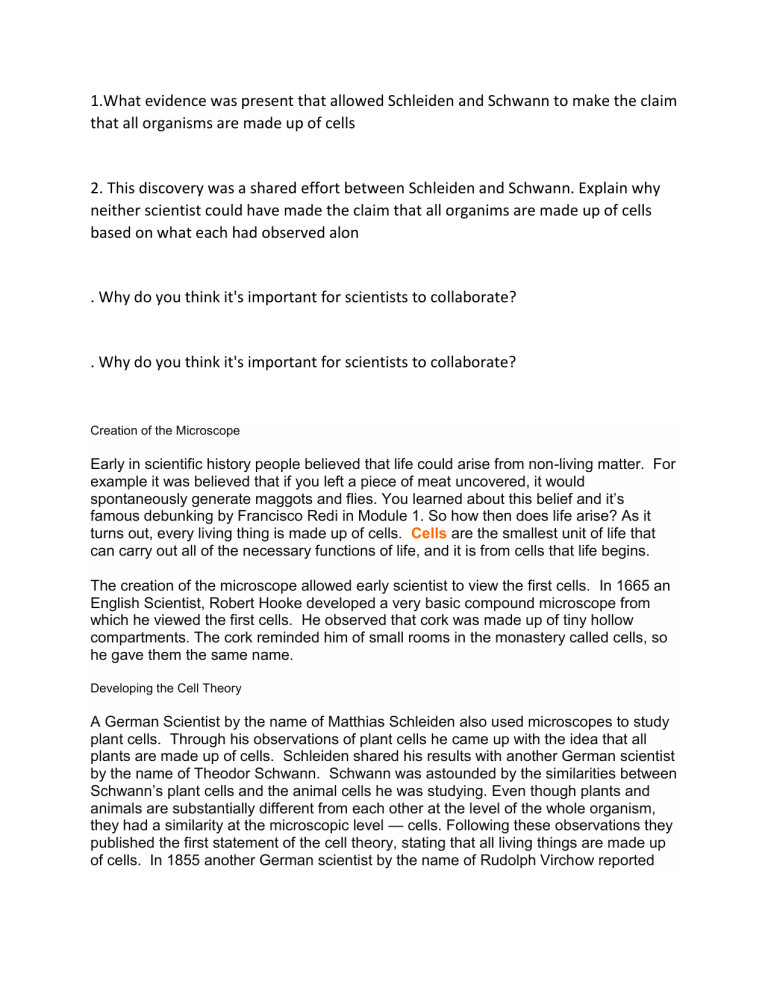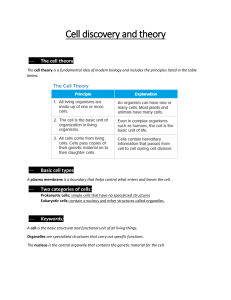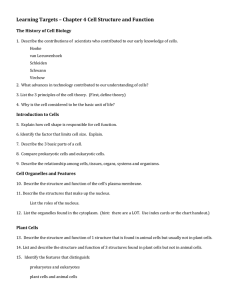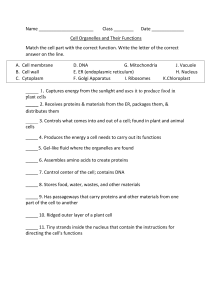
1.What evidence was present that allowed Schleiden and Schwann to make the claim that all organisms are made up of cells 2. This discovery was a shared effort between Schleiden and Schwann. Explain why neither scientist could have made the claim that all organims are made up of cells based on what each had observed alon . Why do you think it's important for scientists to collaborate? . Why do you think it's important for scientists to collaborate? Creation of the Microscope Early in scientific history people believed that life could arise from non-living matter. For example it was believed that if you left a piece of meat uncovered, it would spontaneously generate maggots and flies. You learned about this belief and it’s famous debunking by Francisco Redi in Module 1. So how then does life arise? As it turns out, every living thing is made up of cells. Cells are the smallest unit of life that can carry out all of the necessary functions of life, and it is from cells that life begins. The creation of the microscope allowed early scientist to view the first cells. In 1665 an English Scientist, Robert Hooke developed a very basic compound microscope from which he viewed the first cells. He observed that cork was made up of tiny hollow compartments. The cork reminded him of small rooms in the monastery called cells, so he gave them the same name. Developing the Cell Theory A German Scientist by the name of Matthias Schleiden also used microscopes to study plant cells. Through his observations of plant cells he came up with the idea that all plants are made up of cells. Schleiden shared his results with another German scientist by the name of Theodor Schwann. Schwann was astounded by the similarities between Schwann’s plant cells and the animal cells he was studying. Even though plants and animals are substantially different from each other at the level of the whole organism, they had a similarity at the microscopic level — cells. Following these observations they published the first statement of the cell theory, stating that all living things are made up of cells. In 1855 another German scientist by the name of Rudolph Virchow reported that all cells must come from pre-existing cells. These early discoveries laid a framework for Schwann and Schleiden’s Cell Theory Major principles of the Cell Theory: The cell is the most basic unit of life All organisms are made up of cells All existing cells come from pre-existing cells Amazingly these basic principles are still the same today, and they have helped pave the way for modern biological research. Some organisms like bacteria are composed of only a single cell, while others like animals and plants are composed of trillions of cells that have very specific functions. In order to understand why the cell theory still holds true, and what cells are truly capable of, we need to understand the basic structure of cells. Introduction Think for a minute about your body. What must your body do to stay alive? What organs are in place to help accomplish this task? You probably thought of several things: Your heart pumps blood throughout your blood vessels to deliver nutrients and take away waste. Your stomach digests food so that your body can use the nutrients to live, repair, and grow. Your skin acts as a protective barrier from the “outside” world. Your brain commands and coordinates all of these organs to work together to accomplish the tasks at hand. Organelles Just like organs in your body have specific roles to keep you alive, your cells are composed of structures called organelles that have specific jobs to keep the cell alive. In this lesson you will learn about each of these organelles and how their individual jobs come together to make a living cell. The plasma membrane is a semi-permeable membrane that regulates what enters and exits the cell, as well as helps the cell maintain its basic shape. It is responsible for maintaining homeostasis within the cell. The plasma membrane is composed of a phospholipid bilayer that helps the cell membrane stay fluid. In Module 2 you learned about lipids (fats). These macromolecules are what make the two layers of the phospholipid bilayer. Proteins embedded in this bilayer act as “gates” allowing things in and out of the cell. 5. Please give a brief description of organelles. 6. Describe the structure and function of the plasma membrane. Cytoplasm is a watery substance that can be found inside of the plasma membrane. The cytoplasm is made up of the building blocks of proteins, nucleic acids, ions, and messenger RNA that carry the instructions to help build proteins. Because water is a universal solvent, the molecules dissolved within it easily move and interact with other molecules in the cytoplasm. Ribosomes are small structures in the cell that are responsible for making proteins from individual amino acids. You will learn more about this process in Module 5. DNA (deoxyribonucleic acid) is made up of nucleic acids and carries coded instructions on how to make proteins. You’re probably already familiar with the term “genes” – DNA is what contains all of your genetic code. The nucleus can be thought of as the “master” of the cell. It contains the genetic information (DNA) and instructions for making every protein used in the cell. DNA is tightly packed within the nucleus as chromatin. The nucleus also contains the nucleolus, which is where ribosomes are made. Similar to the plasma membrane that surrounds the cell, the nucleus is surrounded by a nuclear envelope that tightly regulates what can enter and leave. The endoplasmic reticulum (ER) is a network of membranes extending from the nuclear envelope where ribosomes are attached and carry out protein synthesis. Think of this region as the protein workbench where proteins are made from the genetic code being sent from the nucleus. Proteins synthesized by the ER are exported out of the cell, or utilized in the plasma membrane. Attached to the ER is the Golgi Apparatus. This organelle is the packing and shipping house for newly synthesized proteins. Once the ER makes proteins they are moved into the Golgi apparatus where they are modified into their usable form and shipped to their target destination. Their targets could be other organelles inside the cell that are in need of repair, or out of the cell to be used in other regions of the organism. 5. Please give a brief description of organelles. 6. Describe the structure and function of the plasma membrane Lysosomes are the recycling center. They are filled with digestive enzymes that are useful for breaking down biological materials. Macromolecules such as proteins, fats, and carbohydrates are delivered to the lysosome to be digested into their individual components. Once broken down, the individual components (like amino acids from proteins) can be reused to make new proteins and structures. The lysosomes can also “recycle” old organelles that are no longer functioning properly. The cytoskeleton is the structural support for the cell. Just as your skeleton gives your body structure, the cytoskeleton keeps cells intact. Cytoskeletal filaments and tubules span the inside of the cell, moving organelles and keeping cellular machinery attached. Mitochondria are the cellular powerhouses. They are double membrane organelles responsible for converting nutrients – specifically glucose – into ATP through cellular respiration (Module 5). ATP is the only energy currency usable by cells. Without it, nothing in a cell can work. Think about ATP like gasoline for a car: gasoline is the only use able fuel for a standard car, and without gasoline it surely won’t run! 7. Why is the mitochondria considered the "Powerhouse" of the cell Vacuoles are fluid-filled organelles that isolate or dispose of waste, debris, and toxic materials. In plant cells there is one large central vacuole where amino acids, sugars, ions, wastes and toxins accumulate. The central vacuole in the plant cell also helps keep plant cells plump through turgor pressure. Instead of a central vacuole, animal cells have many small vacuoles that dispose of waste, debris and toxic materials. Although we learn about each organelle separately, keep in mind that all organelles work together and are constantly in action. Cells are alive! They are continuously making new proteins, recycling old proteins and other macromolecules, and generating energy to sustain life. 8. What is the function of the endoplasmic reticulum? 9. What is the function of the Golgi Apparatus? 10. Why is the nucleus considered to be the "master" of the cell? Prokaryotic and Eukaryotic Cells All cells from all living organisms can be classified as one of two types of cells: Prokaryotic or Eukaryotic. Prokaryotic cells are the simplest cells, and because of the simple nature of prokaryotic cells, they are only found as single-celled organisms such as bacteria. They do not have a nucleus or any membrane bound organelles. Prokaryotic cells have many ribosomes inside the cytoplasm that are responsible for making proteins from the amino acids in order to build and maintain the cell. The cytoplasm also carries plasmids which are small circles of DNA that carry only a few genes on them, but these genes can provide small advantages for the cell such as antibiotic resistance. The remaining genes can be found in a large circular molecule of DNA located on a region called the nucleoid. The prokaryote also has a rigid cell wall, which protects the cell and supports its shape. Eukaryotic cells are more complex and have a nucleus and membrane bound organelles. Eukaryotes can be found in single-celled organisms such as amoeba and yeast; but different from prokaryotes they can also be found in complex multi-cellular organisms like humans. The largest organelle in eukaryotic cells is the nucleus that encloses the DNA. The remaining organelles are membrane bound organelles that are specialized to perform specific functions within each cell as described in lesson 2. 11. Please describe the differences between a prokaryotic cell and a eukaryotic cell. Give an example of each. Eukaryotic Cells: Animal vs. Plant Both plant and animal cells have many of the same organelles yet they are also very different from one another. Animals acquire most of the nutrients they need from consuming food, while plants must synthesize many of the nutrients they need by using sunlight. Plants also need a way to support their structure and draw moisture from the ground into every cell they contain. Because of these major differences, it seems logical that there would have to be some differences between plant and animal cells. While the primary goals of energy production and growth are the same, the process to get there differs slightly. The Plant Cell The plant cell has three specific organelles that animal cells do not: A cell wall, chloroplasts, and a large central vacuole. The cell wall is a rigid but permeable structure that surrounds the plasma membrane of plant cells. The cell wall protects and supports the plant cell and helps determine the shape of the plant. In addition, the inelastic cell wall avoids collapsing due to turgor pressure, which is an internal water pressure that plants use to help move water from roots to leaves. Unlike animals, plants can’t consume sugars by eating foods; instead they have to generate them. In order to accomplish this, plants contain chloroplasts. Chloroplasts are organelles that carry out photosynthesis, which is the conversion of solar energy into sugars for the plant to use. The central vacuole in plants is significantly different than the vacuoles in animals. The main role of the central vacuole is to maintain water (turgor) pressure within each cell. They have a large capacity for water and can take up anywhere from 30% to 80% of the entire cell volume! Matching the structure to function Many of the cells found in animals do not look exactly like the animal cell shown above. Beginning at fertilization and continuing throughout life, cells become highly specialized for the jobs they are assigned to do. For example heart cells are specialized to contract at regular intervals, which allows the heart to pump. Imagine if a heart cell were placed in your skin – it might feel like you had a constant twitch that would never go away! Because of this specialization, cells change their structures slightly in order to complete their assigned function. One way specialization is accomplished is by changing the amount of each specific organelle that exists within the cell. Extreme examples are red blood cells; they do not contain a nucleus or ribosomes. Instead they have large amount of a protein called hemoglobin that is responsible for carrying oxygen. While red blood cells are great at carrying oxygen they cannot repair themselves resulting in a short lifespan of only 120 days. Cells found in the stomach are specialized to produce large amounts of proteins that help digest food. These cells have larger endoplasmic reticulum and Golgi apparatus in order increase protein production and shuttling to the environment outside of the cell. Levels of Organization As stated in Schwann and Schleiden’s Cell Theory, the cell is the most basic unit of life. These basic building blocks can interact and coordinate with other cells in increasingly complex ways to create large multicellular organisms. In order to understand these relationships, we can organize them by increasing levels of complexity. It’s easiest to understand these relationships by looking at an example. The examples used are from humans, but keep in mind that these same levels of organization exist for all living things. Level 1: The Cell The first level of organization is the cell. Cells are the basic unit of life and usually serve a specific function within an organism. For example, a single heart cell can contract on its own, but it isn’t organized to pump blood. www.sciencephoto.com Level 2: Tissue Tissues are a group of cells working together to carry out a specific function. In this example, a group of heart cells work together to contract in unison and exert force. Similar to stretching one rubber band vs. stretching 30 rubber bands. 30 rubber bands will exert much more force than a single rubber band. www.sciencephoto.com Level 3: Organ Organs are a group of tissues that work together to carry out a specific or related function. Heart tissues group with other tissues to form chambers and the shape of the heart with the specific purpose of pumping blood. Level 4: Organ System The organ system is composed of two or more organs that work together to carry out a specific function. The heart works with the arteries and veins to form the cardiovascular system. The cardiovascular system serves the purpose of delivering blood with oxygen and nutrients to tissues, while removing waste. www.sciencephoto.com Level 5: Organism An organism is the complete collection of all other levels of organization working as a single living thing. The cardiovascular system works with the nervous system, digestive system, musculoskeletal system, etc. to form the complete human. Application of Learning By studying each level of organization alone, it can be easy to miss how each is related. Let’s look at an example from medicine to better understand the relationships. The example we’ll look at is type II diabetes. The description given below is a very basic overview of the disease and includes extreme examples of what could happen if left untreated. These details should be enough to answer the questions below; however, a quick internet search for “Type II diabetes” will provide countless resources that you may also find interesting and useful. Type II diabetes is one of the most common diseases in the United States. Current estimates (2015) are that one in three people will develop type II diabetes over the course of their lifetime, and that the number of people diagnosed will continue to rise over the next several decades. Type II diabetes is a disease that affects how the sugar known as glucose is used in the body. Glucose is the primary source of fuel in the body, and without it the body will no longer function properly. When you eat carbohydrates your body breaks them down into simple sugars – specifically glucose. Glucose travels through your blood stream and is taken into your cells through the plasma membrane with the help of a hormone called insulin. Insulin is produced by the pancreas and is necessary for bringing glucose into the cell. Once inside of the cell, glucose is transported to the mitochondria where it is used as a substrate to make ATP. In type II diabetes, the cells are unable to use insulin properly to bring glucose inside. Even though levels of insulin are high in the blood, the individual cells do not recognize the hormone. As a result, the glucose levels in the blood also become very high, while glucose levels inside the cells become very low and the energy production by mitochondria begins to slow. Over time, the high levels of blood glucose damage other tissues and organs. High blood glucose can damage blood vessels and heart tissue resulting in increased risks for heart attacks. Skeletal muscle that is responsible for strength and movement becomes weak and can wastes away because it isn’t producing enough ATP to maintain regular cellular functions. If the disease is left untreated, the specialized groups of cells in the pancreas that produce insulin become fatigued and die. This leads to further complications and can eventually lead to death if left untreated. When doctors diagnose diabetes, they ask several questions and run several tests that identify potential problems at each level of organization. First they will ask about symptoms. Symptoms of diabetes include feeling thirsty, urinating frequently, feeling tired, and experiencing unexpected weight loss. After matching symptoms to the disease, doctors will order test to measure the amount of glucose in the blood. They may also test how well the pancreas is functioning by measuring insulin through specific tests.






